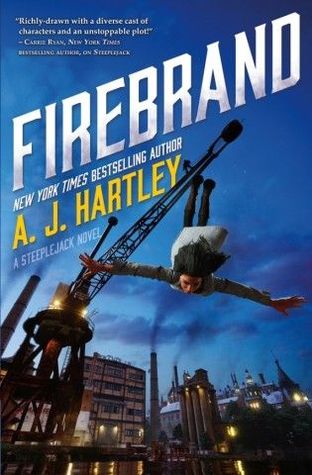I hate, hate, hate coming into a series in the middle (which means no, I haven’t read the first novel in this series, Steeplejack, but I sure plan to soon!), but I have a good personal track record with author A.J. Hartley, so I knew that if anyone could write a good middle book that still stands on its own it would be he.
My assumption, in this case, proved absolutely correct, in case you’re wondering.
Firebrand is the second volume in Hartley’s steampunk-flavored, young adult series “Alternative Detective”, and takes place a few months after the events in the first novel, which took a young woman from “steeplejack” (a person who works up high on the roofs and sides of very tall buildings, mostly cleaning chimneys but also doing repairs and maintenance and other sundry jobs) to amateur detective, and landed her in the very informal employ of a member of her city-state’s Parliament. As this novel opens, Anglet Sutonga is now enjoying an unaccustomed level of financial security and autonomy, but her sense of duty and survival instincts don’t let her get too comfortable, so as the novel opens, she is chasing an infamous cat burglar over the rooftops of Bar-Selehm, which leads her into a whole new mystery of linked and nested conspiracies, exploitation, human trafficking, treason and, of course, murder.

The city-state of Bar-Selehm, not unlike China Mieville’s more famous Bas-Lag, is densely realized as a multi-layered class- and race-war masquerading as a municipality. Hartley based it loosely on, of all things, the nation of South Africa of the 1950s and 1960s (and yes, that’s when that country’s odious Apartheid system was being assembled, meaning that issues of race and class confront the reader on every page), but set it further back in “history”, imagining that a perfect Victorian-era industrial city, complete with a municipal gas infrastructure, sort of paved streets, and factory smoke and soot, was imposed on the southern end of the African continent.
But so, apart from some slightly fanciful animals, there’s not a lot of fantasy or science fiction going on here. Its speculative fiction credentials are resting on the allegory and the city-state’s placement in time, and on the presence in its territory of a fabulous mineral substance called Luxorite, standing in for the real world’s diamonds, but also having the useful property of glowing brightly. One giant hunk of the stuff illuminates the whole city at night from a great Beacon at Bar-Selehm’s heart, for instance.
Anglet Sutonga is a Lani (this world’s equivalent to the subcontinental Indians brought along by the English to help colonize southern Africa), so she occupies that uncertain middle-ground in the complicated class structure of the city. She’s got family in a suburb-cum-ghetto called The Drowning where most of the Lani live. Her previous adventures have netted her some black friends, most notably a lady newspaper reporter, Surenya, and a saintly tribal ambassador/goat herder named Mnenga who is in love with Anglet but doesn’t show up for a long time because he’s got his own stuff to do. She’s also got some white friends, including the MP who is her nominal boss, and his sister Dahria. The former is barely a character but suitably heroic when he needs to be; the latter has a fascinatingly complicated attitude toward Anglet that never quite becomes the easy friendship the reader gets led to expect but is still very satisfying.*
Everybody helps Anglet as she solves multiple mysteries, from who was that cat burglar really, to who murdered a high class society woman, to what’s been happening to all of the boatloads of black war refugees (There are other colonial powers than those that settled Bar-Selehm on this not-African continent, and those other powers are still actively subduing other tribes up north) arriving miserably in town and then disappearing, to what’s really going on inside the city’s most powerful and exclusive social club, and what it all has to do with a set of stolen plans for an overwhelmingly powerful new weapon. All against a backdrop of imminent white nationalist takeover that closely parallels what happened in South Africa in actual history – making this a terribly timely feeling book for young readers in 2017.
There is action galore, mostly the kind of steampunk parkour one would expect of a detective who used to be a steeplejack, incredibly tense and fraught personal interactions, just enough political drama to entertain older readers who like that sort of thing but not so much of it that its intended young adult audience would get bored, and intrigue, intrigue, intrigue.
All this and a truly exciting heroine, flawed enough to be believable but dashing enough to be inspiring to boys and girls and non-binarians alike. There is, in sum, no reason for you not to make with the clicky and get this thing in your hands the second it’s available. And watch eagerly for the next one. And so on.








